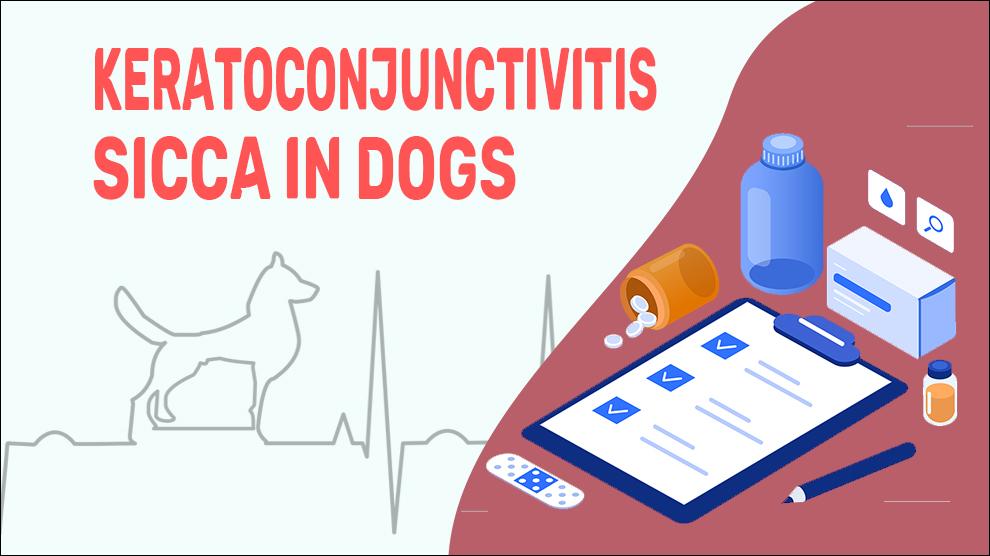Canine keratoconjunctivitis sicca (KCS) is characterized by chronic inflammation of the cornea, lacrimal gland, and conjunctiva, secondary to a deficiency of the precorneal tear film (PTF). Commonly referred to as dry eye syndrome, this condition is due to the lacrimal gland and/or nictitans gland’s insufficient production of the aqueous portion of the tear film.
KCS in dogs is not completely understood, however, many reasons are attributable including congenital, infectious, idiopathic, metabolic, neurogenic, drug-induced, iatrogenic, radiation, and immune-mediated (the most prevalent form in dogs).
KCS is often confused with bacterial conjunctivitis. When wrongly treated with topical antibiotics used to treat bacterial infections, the pet improves initially but the clinical signs resurface after the discontinuation of the treatment. If left untreated or not properly treated, the condition progresses to corneal opacification leading to blindness.
The worldwide used term “keratoconjunctivitis sicca” refers only to the later stage of the disease; broadly this is called “Canine Immune-mediated Lacrimal Syndrome (CILS)”.
Symptoms Of Keratoconjunctivitis Sicca
Initial stage:
- Excessive blinking
- Blepharospasm
- Painful, red, and irritated eyes
- Prominent nictitans (third eyelid)
- Mucoid to mucopurulent ocular discharge
Intermediate stage:
- Corneal ulceration
- Corneal scarring
- Conjunctival hyperemia
- Secondary bacterial infection may also occur
Final stage:
- Hyperpigmentation
- Corneal perforation
- Neovascularization
- Fibrosis
- Blindness
Treatment Options For Keratoconjunctivitis Sicca
- Conventional treatment consisted of substituting the lost tears with the use of false tears but these solutions could not control the inflammatory process which continues progressing and do not contribute to some of the most important compounds of tears such as antimicrobial agents, nutrients, and growth factors. Furthermore, as they are quickly evaporated, they have to be frequently administrated.
- Artificial tear drops STT I values: 0 mm/min and 5–7 mm/min (once an hour administration).
- If STT I values are >7 = six times a day.
- Artificial tear drops substitutes are hyaluronic acid, polyvinyl alcohol, polyvinyl pyrrolidine, and methylcellulose.
- Cyclosporine A (CSA), pimecrolimus, and tacrolimus - are noncytotoxic immunosuppressants.
- CSA disrupts the immune-mediated reaction against the cornea, conjunctiva, and lacrimal glands. Even for normal eyes, It acts as a lacrimomimetic agent and has an anti-inflammatory effect too.
- Acetylcysteine: a mucolytic agent to treat mucin excess on the ocular surface.
- Pilocarpine: used to treat KCS with neurogenic origin(parasympathomimetic agent)
Home Remedies For Keratoconjunctivitis Sicca
- Gently washing the eyelids using baby shampoo and/or applying warm compresses to the eyes can help discharge the oil in the tear glands.
- Add a humidifier to a furnace and/or use a bedside humidifier (especially in cold weather) can bring some moisture back into the dry air.
- Dogs with dry eyes should avoid too much air movement such as usage of fans or in windy areas.
- Pet eye lubricating gels are another option (best to apply at night or before bedtime).
Prevention Of Keratoconjunctivitis Sicca
The best way to prevent dry eye is to maintain proper eye hygiene with products engineered specifically for dogs and to maintain overall health.
Affected Breeds Of Keratoconjunctivitis Sicca
American Cocker Spaniel, Bloodhound, Boston Terrier, Cavalier King Charles Spaniel, English Bulldog, English Springer Spaniel, Lhasa Apso, Miniature Schnauzer, Pekingese, Pug, Samoyed, Shih Tzu, West Highland White Terrier, Yorkshire Terrier
Additional Facts For Keratoconjunctivitis Sicca
Causes:
- Metabolic: Hypothyroidism and diabetes mellitus
- Infectious: Leishmania, canine distemper virus, etc
- Drug-induced: Temporary: local or systemic anesthetic, atropine, and the sedatives
- Permanent: Potentiated sulfonamides
- Neurogenic: Middle-aged female dogs- associated with dry/crusted ipsilateral nostrils
- Radiation: Less common
- Iatrogenic: In the case of “cherry eye”, surgical removal of the gland of the third eye.
- Immune-mediated: Predominant cause of KCS.
Pathophysiologically, KCS can be divided into two types:
- Inadequate secretion of tears or decreased tear production
- Extreme tear evaporation (brachycephalic breeds)
Morbidity:
- Annual incidences in USA: 0.3%–1.50%.
- Worldwide: 1%
- KCS is very common in European countries.
- There is some belief that female dogs are more predisposed than males.
- Occurrence of 15% in dogs treated with oral NSAID Etodolac and with Felbamate (an antiepileptic drug)
Diagnosis:
- Biomicroscope
- Schirmer Tear Test strips
- Tear film break-up time test
Prognosis:
The prognosis for dogs diagnosed with the dry eye has never been better with today's tear-stimulating drugs. KCS requires lifetime medical care.
Most dogs enjoy a pain-free life with careful attention and monitoring.
If the condition is not diagnosed earlier in the course of the disease or if it has progressed to deep corneal scarring, the pet may lose its vision or may not respond fully to the treatment.
When To See A Vet
Contact your vet right away, if you notice any of the following:
- If your dog blinks excessively or the eyes look painful and red continuously.
- A stringy, ropy discharge to mucopurulent (mucus and pus) ocular discharge.
Food Suggestions For Keratoconjunctivitis Sicca
- Whole, unprocessed foods
- Low-carb dog food
- Lean meat protein
- Shrimp, salmon, tuna, cod, halibut, trout, herring fish
- Blueberries, broccoli, carrots
- Sweet potato, tomato
- Leafy green vegetables (lettuce, spinach, salad greens, parsley, collard greens)
Conclusion
For pets with KCS, Early diagnosis with prompt treatment, as well as routine follow-up examinations is of paramount importance. In most dogs, the prognosis can be excellent with the maintenance of vision and long-term comfort.

















